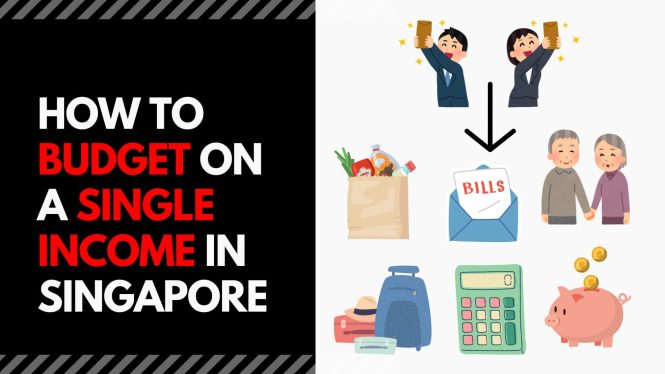Taking a career break was one of the riskiest decisions we made as a family, and we took great care to ensure we could afford it. The last thing you want is to regret that decision or realize you ran out of money earlier than you thought, and put yourself in a difficult position.
Luckily, we managed it well, and now, we are celebrating 2 years of career break. As we are looking to take an extended career break, the focus has turned to ensuring that we can sustain this lifestyle. Surviving on a single income in Singapore is hard, but doable. We do need to put extra thought into budgeting every month to ensure that we do not blow our budget for that month.
Like many families in Singapore, we have fixed expenditures that we would need to budget, along with living and ad-hoc expenses that pop up now and again. If you have read our previous post – our main expenses are:
- Parents Allowance
- Bills
- Daily Expenses
- Home Crisis And Improvement Fund
- Family Fund
- Savings
Knowing where our money goes every month is very helpful to our family budgeting as we will know exactly what should be paid for and the amount we are paying. These are the exact steps we take every month to allocate our budget to ensure that all essential bills are paid for, and we have food on our table.
Step 0: Know When Is PayCheck Time
Our salary gets credited at the end of the month. Once our salary comes in, most of it will go to clearing most of our fixed expenses. Once we are done with those, whatever remains is what we have to work with for our family’s spending.
Step 1: Pay The Parents Tax
We usually pay the parent’s tax at the start of every month. This is usually done through a scheduled fund transfer at the start of the month so it takes the admin load off us, and our parents can have a little spending power for the month.
Step 2: Pay The Bills
We usually schedule the bills to be paid every first week of the month whenever possible so that we do not have outstanding bills to worry about at the end of the month. In addition, we will also avoid incurring any potential late charges for missing a bill payment.
Side note, you can actually call in to the customer service of most services to ask for an adjustment of bill period. For us, we request for our bills to start at the start of the month, and end at the end of the month. This means our bill would be sent to us around the first week of the month, and we can quickly clear them and streamline our budget.
The customer service wait is often terrible, but once you clear them up, budgeting is so much simpler as you can make better decisions with whatever amount of money remaining. We do not like the idea of “reserving” x amount for this bill etc, as it takes a lot of mental load to remember these nitty-gritty numbers.
Step 3: Plan for Meals & Groceries
We meal plan. That’s the easiest way to control our budget. By planning our meals in advance, we also pre-cooked some of our meals so that we have some breather during the hectic days. Meal planning helps us to ensure that we do not overspend on groceries (we hate wasting food!) and that we do not have to keep making trips to the supermarket. Our time is a lot more streamlined as well, and we get to spend more time with our little one.
We also make bulk purchases for consumables such as toilet rolls, shampoos, and cooking essentials like oil and butter. This allows us to make use of various online shopping platforms to get better deals (hello vouchers!) and we do not have to waste energy to lug them home from the supermarket.
Step 4: Plan for Outings & Travels
Now that our little one is more active, we are always planning for different places to visit, and tiny excursions to go for. We usually try to cater for some overseas trips along with local visits to places of interest. These outings are usually planned in advance for us to make bookings and start saving for them.
By making advanced planning, it allows us time to allocate part of our income to fund these outings. Yes, it can be a little time-consuming, but this is what works for us, and we have since then taken multiple family trips without worrying about blowing our budget.
Step 5: Plan Ahead For Home Improvement
Technically, we have had our house for many years, and we do see furniture and fittings falling apart (the quality of things seems to deteriorate quickly). We do have a list of home improvements we love to do, but we are settling the priorities first. We focus on getting quotations or finding cheaper alternatives (that is DIY lol) to fix the issues and allocating part of our budget to get these priorities fixed.
While we love to get everything fixed by professionals, we understand that repairs in Singapore are expensive and we are only prioritizing absolutely needed repairs. If you are not a homeowner, you probably need some context. Some of our repairs or home improvements over the years are – getting a brand new fridge and stove and washing machine and hob and oven and microwave due to equipment breakdown, and flooring pop-up (not sure how that happens lol).
Step 6: Pray For Savings
Whatever remains goes to our savings. With inflation being so bad over the past few months, we were honestly glad if there were any leftovers from our income. Usually, it is “recommended” to plan for savings before spending the rest of your money. In our case, we cannot do that as we are mostly “moonlight clan” most of the months, and it really does not make sense to budget for saving if we cannot make it work.
Do what suits best for you and there are other ways to build up savings. Bonus at work usually is a great way for us to replenish our savings and living a modest lifestyle also helps us ensure that our money is spent wisely.
Last Updated: 26 Sep 2024




